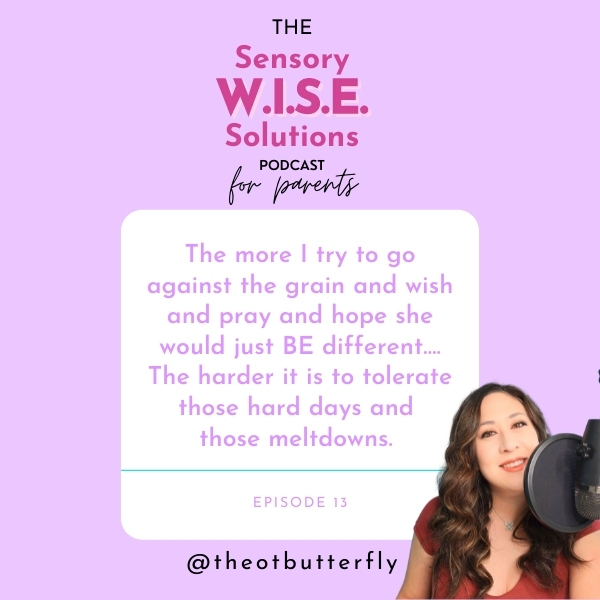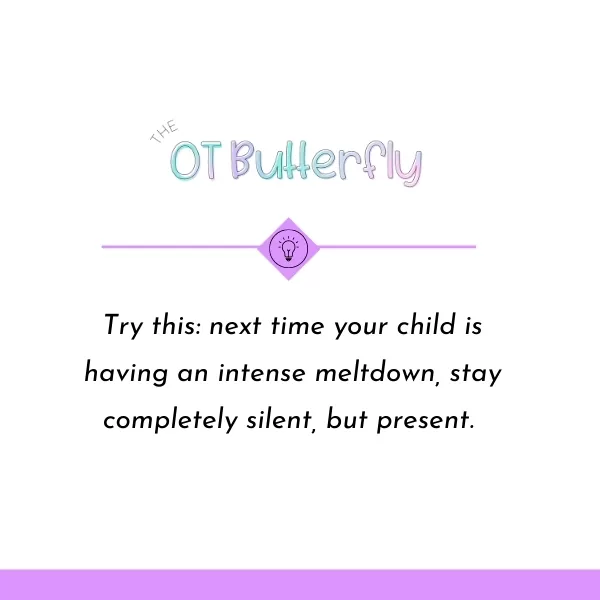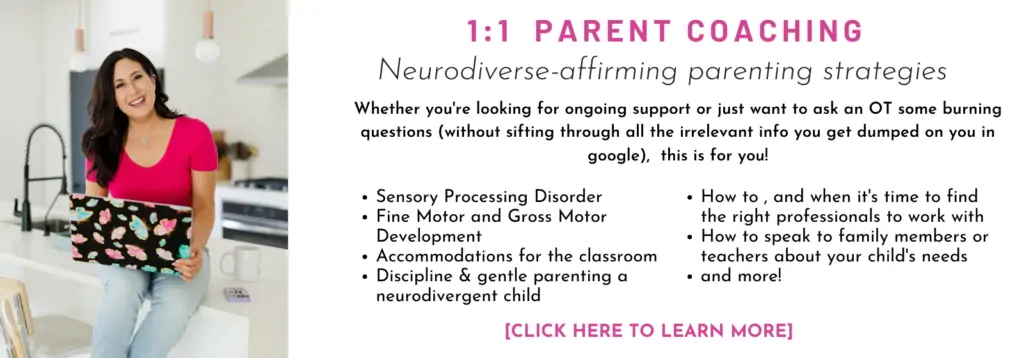Get your FREE sensory profiles cheat sheet >>click here<<
The one thing you need to know about meltdowns
Hey everyone! Welcome back to the podcast. Today’s topic is one that I have way more experience in than I wish I did.
Yup… I’m talking about meltdowns. Now I want to be clear here, and if you’ve followed me for a while you know this is one of those hills I’d die on… a meltdown is VERY DIFFERENT than a tantrum. If you want to know more about how I define and see the difference, head to my instagram @theotbutterfly and checkout my highlights called meltdowns. But very quickly, for the purpose of this episode- here’s my take on tantrums vs. meltdowns in like 30 seconds.
Difference between Tantrums & Meltdowns
Tantrums and meltdowns can sometimes LOOK the same. Crying, kicking, screaming, hitting biting. But, typically once a tantrum is over (and they usually end much faster than a meltdown- like less than 10 minutes), the child kind of wipes their tears and moves on. When a child has a meltdown (usually stemming from anxiety or sensory overload), not only does the actual duration of the meltdown last longer (Our bad ones last 45-90 minutes) but after the meltdown the child is typically still dysregulated or just “off” for some time after. Sometimes the rest of the day.
Now I want to be clear… tantrums and meltdowns can both occur in neurotypical children AND in neurodivergent children.
An Autistic, anxious or SPD child can have a “plain vanilla” tantrum”, just as much as a neurotypical child can experience a sensory overload meltdown. The difference is, neurodivergent children are simply more prone to having more meltdowns than tantrums.
You Can’t Stop Meltdowns
Now that we have that settled, here’s my point for today’s episode. The ONE thing you NEED to know about meltdowns.
And that’s…the fact that you can’t stop meltdowns.
You can’t stop a meltdown once it happens. Not only are you not responsible for this, not only is it an uphill battle if you TRY to stop it, but I’d also argue that you’re doing your child a disservice if you continue to focus on stopping them from having meltdowns.
It’s not your job to stop the meltdowns. It’s not your goal. It’s not even on the menu. Stop looking at that option. It’s not available.
Now, hear me out- I KNOW meltdowns suck. I am no stranger to meltdowns… the real bad ones (see episode 2 and 3 for my stories on this) are engrained in my memory and we still have some awful ones. And of course if I had a magic lamp a genie could grant me a wish, wishing my child wouldn’t have meltdowns would probably be top of the list.
But the entire idea of being a neurodivergent individual is that their brains are literally wired differently. They process things differently and as a result, experience things differently, especially stressful situations and show their stress differently.
I’m not saying you’ll be dealing with 90 minute meltdowns for the rest of your life… but I am saying that acceptance is part of the process.
I’ve learned SO MUCH from my own therapy as an anxious mom to learn to accept my anxiety rather than hide it or push it away that I’ve started applying that to some aspects of motherhood and raising a neurodivergent child.
The more I try to go against the grain and wish and pray and hope she would just BE different…. The harder it is to tolerate those hard days and those meltdowns.
Accepting that meltdowns is part of how her brain experiences things helps… a little. I’m not going to lie: they still suck, but this perspective helps take the edge off… a little.
I’ve heard stories from a lot of Autistic adults (I actually just interviewed an Autistic adult in episode 12) who still experience some form of meltdowns in their adult lives.
They still experience sensory overload and stress from routine change that can just completely overwhelm their nervous system and result in a meltdown, which looks different in adulthood but is still a major fight/flight response. But you know what they also say? They’ve learned what tools work for them and what to do when they meltdown and how to advocate with friends/family/coworkers to let them know what they need during a meltdown.
What You Can Do During a Meltdown
Our job isn’t to STOP the meltdowns and try to distract them mid-meltdown or try to completely shut down their feelings by saying “its okay” or “it’s not a big deal”. Our JOB is – well, actually it’s 2 things.
Our job is to:
- Keep them safe during the meltdowns. We can’t let them hurt themselves or hurt others. That, by far is the number 1 goal.
- But secondly, our job is to support them through the meltdowns by giving them what they need in that moment, and moments after. And newsflash, MAJORITY of individuals who meltdown just need PURE SILENCE during the meltdowns.
I have sat through many meltdowns with my own daughter and with children I work with who completely escalate with any extra auditory input, which includes things like “oh you’re so mad” or “I know you’re really sad the cookie broke” or even the “you’re okay… you’re okay”.
I think sometimes we think that our kids expect us to say stuff to them, especially when our kids talk during the meltdown or worse- say terrible things TO US… and it can be so hard to just sit there in silence, but trust me… for most kids, this is the path of least resistance.
So depending on the child- whether it’s a client or my own child, I know usually what they want- sometimes it’s a rub on the back, sometimes it’s just my physical presence, sometimes it’s eye contact, sometimes it’s NO eye contact… but MOSTLY… it’s no words.
Then, usually after the meltdown when I can tell there’s a little window… I’ll offer some words of support and validation and offer a hug or any other heavy work or physical touch that may be regulating for them.
Demystifying Meltdowns Workshop for Parents
Looking for the best ways to support your neurodivergent child through intense, 20+ minute long meltdowns? The answer lies in supporting them through all 4 stages: before, during, after and BETWEEN the meltdowns. Grab this pre-recorded workshop for my step by step guidance.
Now here’s the catch:
Staying silent during the meltdowns and not trying to stop them can be SO HARD.
Because we’re not robots, we have our own nervous systems to protect and we’re not always regulated ourselves. Also, staying silent during the meltdowns doesn’t mean that our kids will have fewer meltdowns.
But LONG TERM… we’re showing our kids that we accept them, meltdowns and all. We’re showing them that they have the right to meltdown if that’s what their brain tells them to do. We’re showing them what tools they can use or ask for (yes, silence is a “tool”) during a meltdown so that as they get older they know what works best for them.
My mental process when my daughter starts having a meltdown is first to examine the environment and ask myself “can my child safely meltdown here?” Sometimes it’s at home when my husband is on a work call, so I’ll have to move her to a room where she can be safe AND meltdown.
Once I determine she is in a space where she can meltdown all she wants, I plant myself down and “buckle up” then, limit the auditory input and ride the wave.
NOW…there are days or times when you really don’t have the time and CAN’T do this for other reasons, I get that. Sometimes it’s really an inconvenience in your schedule to do this, or there are other siblings… or maybe its because you’re having a terrible day yourself.
You might slip up or say something or do something that you wish you didn’t. And that’s okay.
I like to shoot for at least 75-80% of my responses to be the “ideal”.
At the VERY least you always have the option to apologize and repair with your child later. You can apologize about losing your temper in the middle of their meltdown. You can apologize for yelling. It’s good for you to model making some mistakes and taking responsibility for those mistakes later.
Alright, that’s it. This may not have been the meltdown magic pill tip you were looking for, but at the very least I hope it gives you the permission you needed to know you don’t have to be perfect and the permission to sit still and be quiet during a meltdown, that you don’t have to be the bandaid for your child’s emotions.
Links:
Free Demystifying Meltdowns guide: www.theotbutterfly.com/meltdowns
instagram: @TheOTButterfly www.instagram.com/theotbutterfly
Website/blog: www.theotbutterfly.com
Email: LauraPetix@TheOTButterfly.com
Work with me: www.theotbutterfly.com/parentconsult
More SPD parent resources: www.sensorywisesolutions.com
Buy me a coffee & ask me a question for a future episode: www.theotbutterfly.com/coffee








